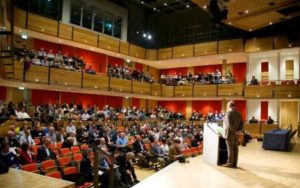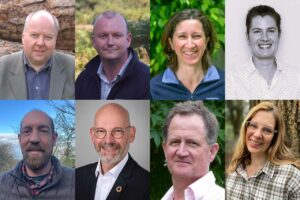Biophilia, Economics and Urban Collaboration at TPBE II
The Trees, People and the Built Environment conference took place 2-3 April at the University of Birmingham, with record attendance of over 400 delegates. Major themes to emerge from the conference included the economic and social benefits of urban trees, the innate connection of human beings with nature (biophilia) and the need for better collaboration between natural and built environment specialists for the benefit of urban environments.
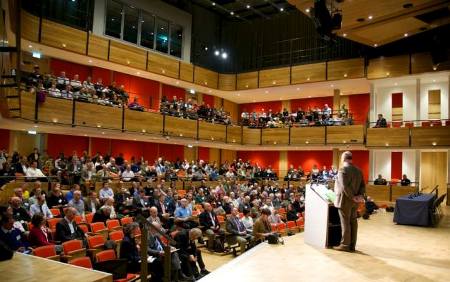
Mark Johnston, Conference Chair, takes the podium for the opening ceremony
TPBEII Day 1: Economic Value of Trees and Urban Tree Collaboration
Day 1 included presentations from Social Research Scientist, Dr Kathleen Wolf, the US Morton Arboretum’s Head of Research, Dr Gary Watson, and leading UK architect Sir Terry Farrell, in addition to a video address from HRH the Prince of Wales.
Presenting her paper, Invest from the Ground Up! Economics of trees and retail environments, Dr Wolf outlined the numerous human benefits that can be gained by planting urban areas, including increased retail sales, reduced stress and lower mortality and illness. Speaking of the economic benefits in particular, she said:
“Studies have found that nearby trees, particularly large ones, can boost the price of a home from 2% to 15%. Local governments capture those price effects in sales or property taxes across neighbourhoods, providing the revenue needed to manage trees so they remain healthy and vital for decades.”
Sir Terry Farrell, who had been expected to give an opening address, was replaced by Farrells Partner John Letherland, due to Sir Farrell’s last minute obligations to Government in relation to the Farrell Review. Letherland gave a stirling presentation of Farrell’s work The Urban Forest: Integrating Approaches in his absence. The presentation highlighted how green infrastructure can be a catalyst for development. He said:
“People don’t always understand the system of interdependency that exists in nature, which also exists in urbanism. Our work is to put this message out and try to bring a richer urban environment into our schemes.
“An environment where growth does not destroy place is fundamentally important.”
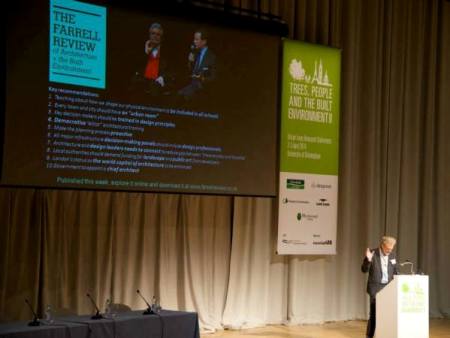
John Letherland addresses TPBE II
Delegates were also treated to a video address from Sir Farrell, which emphasised his commitment to green infrastructure. Speaking of the Farrell Review, he said:
“I have really emphasised that Landscape is an integral part of all design reviews. In fact, we have called them the place reviews as an acronym; Planning, Landscape, Architecture, Conservation and Engineering. So I see the role of Landscape, and indeed of trees in urban spaces as a very vitally important part of our urban place-making.”
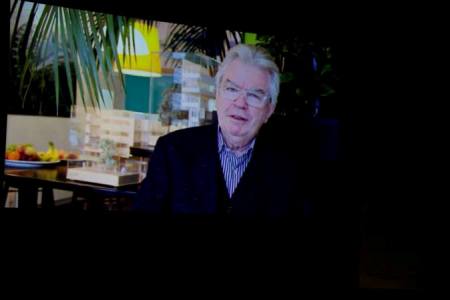
Sir Terry Farrell Video Address
Royal Support for TPBE II
The opening session also featured a short video from HRH The Prince of Wales, which offered his support for the conference and promoted better collaboration between natural and built environment professionals. He said:
“This conference is vital, because it brings together, for only the second time in the United Kingdom, the various professional organisations that can play such a major role in planning and managing our urban forests. One of the main reasons for calling these Trees, People and the Built Environment conferences is the potential synergies and fresh initiatives that can come out of the exchange of ideas and practice between all the relevant professionals.”
TPBE II Day 2: Birmingham Announced UK’s First Biophilic City
On day 2, delegates heard from Nick Grayson, Climate Change and Sustainability Manager at Birmingham City Council, who is leading the development of Birmingham as the UK’s first biophilic city. He said:
“Birmingham is the first UK biophilic city. The Biophilic Cities Network, was launched in October 2013, in recognition of the need for people to access and respond to nature as part of their daily lives.
“The Biophilic Cities Network currently consists of 11 pioneer cities, all at various stages of this transformative journey, from 19th or 20th century cities to new global 21st century cities; measuring their future success on their local and global imprint, on ecosystems and well-being. As Birmingham joins this group of pioneers, it is timely that this year the Trees, People and the Built Environment II conference is hosted here, highlighting, among other things, that green infrastructure and urban forestry can help provide the resilience that a city’s built environment needs.”
TPBE II was also honoured with the presence of Professor Tim Beatley, Teresa Heinz Professor of Sustainable Communities, University of Virginia, who pioneered the biophilic cities project. He explained how he has built a network of cities that consider the benefits of nature to their urban populations – including physical and mental health, economic and climate change benefits – and who are committed to putting urban greening at the forefront of all planning decisions. This includes the promotion of biophilic design – buildings, street furniture, and landscape architecture that include natural features and qualities: abundant daylight, natural ventilation, plants and trees.
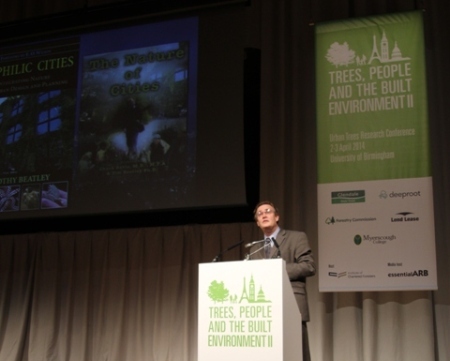
Prof Tim Beatley
In his presentation Cities and Nature: the Global Shift Towards Biophilic Cities, Prof Beatley said:
“Biophilic cities recognise the power of forests to heal us, reduce stress and help us. The idea of forest bathing [is the] notion of walking through a forest, stress levels go down, immune system is boosted.
“We are very excited about the promise, potential, and ways it resonates as a positive future vision of cities.”
Read More
Birmingham joins San Fransico and Oslo in global green cities club (The Guardian)
Support message from Prince Charles urges tree professionals to collaborate (Horticulture Week)
iTree can flag up problems in urban trees population, event hears (Horticulture Week)
Trees, People and Buildings (RICS)
The critical role of trees in cities is too often forgotten (Architects Journal)

